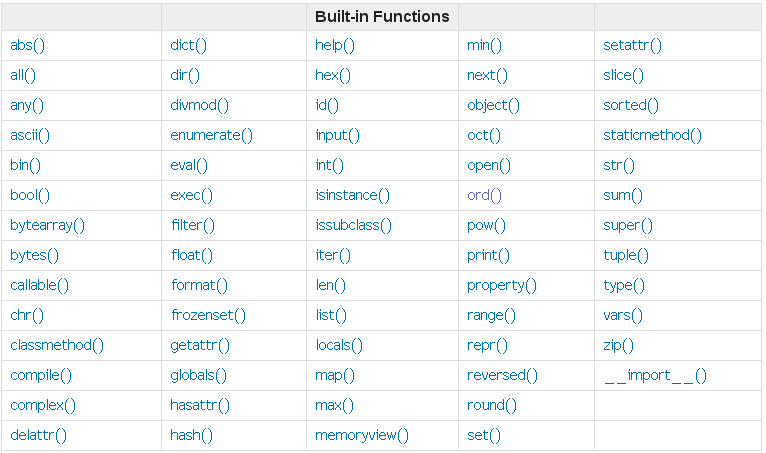Python 内建函数小结
Python 3.5.1 Anaconda 4.0.0 (64-bit)
链接:https://docs.python.org/3.5/library/functions.html?highlight%EF%BC%9Dprint#hasattr
abs
abs(x):返回x的绝对值,若是复数,则返回其大小
In [67]: abs(complex(3, 4))
Out[67]: 5.0all & any
all(iterable):当iterable里所有元素都是True时才返回True,用于判断iterable是否都满足某个条件 (英文: Return True if all elements of the iterable are true (or if the iterable is empty))
any(iterable):当iteralbe里存在元素是True时就返回True,用于判断iterable是否存在满足某个条件的元素(英文: Return True if any element of the iterable is true. If the iterable is empty, return False.)
In [52]: s = Series([1,2,3],index=['a','b','c']) #Series是iterable类型的
In [53]: all(s>0)
Out[53]: True
In [54]: any(s==2)
Out[54]: True
In [55]: lst = [1,2,3] #list不是iterable类型的,无法成为all和any的参数
In [56]: all(lst>0)
Traceback (most recent call last):
File "" , line 1, in
all(lst>0)
TypeError: unorderable types: list() > int() ascii & repr & eval
ascii(object):把object输出一个打印格式良好的(printable)字符串,但会避开non-ascii的字符,使用 \x \u 或 \U 来表示
repr(object):把object输出一个打印格式良好的(printable)字符串
eval(expression, globals=None, locals=None):参数是一个表达式expression,在当前环境(也可由globals和locals来设定)执行/计算表达式的值,一般来言,对于很多类型的变量obj,总是有obj=eval(ascii(obj))=eval(repr(obj))成立
In [73]: data
Out[73]: {'a': 'A', 'b': 2, 'c': 3.0}
In [74]: ascii(data)
Out[74]: "{'b': 2, 'a': 'A', 'c': 3.0}"
In [75]: repr(data)
Out[75]: "{'b': 2, 'a': 'A', 'c': 3.0}"
In [76]: ascii(data) == repr(data)
Out[76]: True
In [80]: data == eval(ascii(data))
Out[80]: True
In [81]: data == eval(repr(data))
Out[81]: True
In [82]: x = 1
In [83]: eval('x+1')
Out[83]: 2
In [84]: eval('0x19')
Out[84]: 25
In [85]: eval('0b1011')
Out[85]: 11bin & hex & oct
bin(x):把x转化为二进制格式字符串,以0b开头
hex(x):把x转化为十六进制格式字符串,以0x开头
oct(x):把x转化为八进制格式字符串,以0o开头
In [94]: bin(4)
Out[94]: '0b100'
In [96]: hex(24)
Out[95]: '0x18'
In [96]: oct(21)
Out[96]: '0o25'class
bool & bytearray & bytes & float & frozenset & int & list & object & set & str:省略
chr & ord
chr(i):返回的字符的unicode code point是i
ord(c):返回c的Unicode code point,与chr正好相反
In [114]: ord('a')
Out[114]: 97
In [115]: chr(97)
Out[115]: 'a'
In [116]: chr(8364)
Out[116]: '€'classmethod & staticmethod
classmethod(function):省略
staticmethod(function):省略
compile
compile(source, filename, mode, flags=0, dont_inherit=False, optimize=-1):Compile the source into a code or AST object. Code objects can be executed by exec() or eval(). source can either be a normal string, a byte string, or an AST object.
complex
class complex([real[, imag]]):返回复数,参数为1个或两个数字,或1个字符串
In [117]: complex(2, 3)
Out[117]: (2+3j)
In [118]: complex('2+3j') #当是字符串时,+或-两边不能有空格
Out[118]: (2+3j)delattr & getattr & setattr & hasattr
delattr(object, name):删除object的属性name
getattr(object, name[, default]):得到object的属性name
setattr(object, name, value):设置object的属性name的值为value
hasattr(object, name):判断object是否有属性name
dir
dir([object]):无参数时,返回当前scope里所有变量名称,有参数时,返回当前参数的所有属性和方法
divmod
divmod(a, b):若两参数是整数,则返回参数之间的商和余数,即
divmod(a, b)=(a//b, a%b)
In [140]: divmod(10, 3)
Out[140]: (3, 1)enumerate
enumerate(iterable, start=0):参数为一序列或者其他有next方法的iterator,返回index和value
In [141]: st = ['Spring', 'Summer', 'Fall', 'Winter']
In [142]: list(enumerate(st))
Out[142]: [(0, 'Spring'), (1, 'Summer'), (2, 'Fall'), (3, 'Winter')]
In [143]: list(enumerate(st, start=2)) #可以设置index计数的起始位置
Out[143]: [(2, 'Spring'), (3, 'Summer'), (4, 'Fall'), (5, 'Winter')]exec
eval(expression, globals=None, locals=None):执行一个字符串代码或代码对象,可以通过globals或locals参数设置执行的范围
filter
filter(function, iterable): (item for item in iterable if function(item)) if function is not None and (item for item in iterable if item) if function is None
In [148]: func = lambda x: x>2 #准确来说,function参数更像是一个筛选条件,满足筛选条件的元素留下
In [149]: list(filter(func, [1,2,3,4]))
Out[149]: [3, 4]
In [150]: [item for item in [1,2,3,4] if func(item)]
Out[150]: [3, 4]format
format(value[, format_spec]):省略
globals & locals & vars
globals:省略
locals:省略
vars([object]):省略
hash
hash(object):返回object的hash值
In [166]: hash(5)
Out[166]: 5
In [167]: hash(5.0)
Out[167]: 5
In [168]: hash(5.1)
Out[168]: 230584300921368581help
help([object]):返回参数的帮助文档
id
id(object):返回object在内存中的地址位置
input
input([prompt]):读取键盘输入并返回该输入值
In [178]: name = input('Enter your name: ')
Enter your name: Xiaoming
In [179]: name
Out[179]: 'Xiaoming'isinstance & issubclass
isinstance(object, classinfo):判断object是否属性classinfo类
issubclass(class, classinfo):判断class是否是classinfo的子类
In [181]: isinstance([1,2,3], list)
Out[181]: Trueiter
iter(object[, sentinel]):省略
len & sum
len(s):计算s的长度
sum(iterable[, start]):计算iterable里各元素的和
map
map(function, iterable, …):对iterable里每个元素执行函数function
In [195]: func = lambda x: x+1
In [196]: list(map(func, [1,2,3]))
Out[196]: [2, 3, 4]max & min & sorted
max(iterable, *[, key, default]) & max(arg1, arg2, *args[, key]):按照key指定的规则返回iterable里最大的元素
min(iterable, *[, key, default]) & min(arg1, arg2, *args[, key]):与max类似,不过是最小的元素
sorted(iterable[, key][, reverse]):按照key指定的规则对iterable里各元素排序
In [206]: max([2,3,4], key=lambda x:x%3) #返回列表里除以3的余数最大的元素
Out[206]: 2
In [208]: min([2,3,4], key=lambda x:x%3) #返回列表里除以3的余数最小的元素
Out[208]: 3
In [207]: sorted([2,3,4], key=lambda x:x%3, reverse=True) #与上面差不多,只不过是全元素排序
Out[207]: [2, 4, 3]next
next(iterator[, default]):返回iterator下一个元素
open
open(file, mode=’r’, buffering=-1, encoding=None, errors=None, newline=None, closefd=True, opener=None):按照模式mode以编码encoding打开file以供读/写/执行/其他,file是文件的绝对/相对路径名(包括文件名)
| Character | Meaning |
|---|---|
| ‘r’ | open for reading (default) |
| ‘w’ | open for writing, truncating the file first |
| ‘x’ | open for exclusive creation, failing if the file already exists |
| ‘a’ | open for writing, appending to the end of the file if it exists |
| ‘b’ | binary mode |
| ‘t’ | text mode (default) |
| ‘+’ | open a disk file for updating (reading and writing) |
| ‘U’ | universal newlines mode (deprecated) |
power
power(x, y[, z]):相同于x**y
print(*objects, sep=’ ‘, end=’\n’, file=sys.stdout, flush=False)
property
class property(fget=None, fset=None, fdel=None, doc=None):定义一个property类,有get/set/del方法
range
range(start, stop[, step]):返回从start到stop,以step为间隔的数字序列
reversed
reversed(seq):让seq里各元素顺序
In [216]: list(reversed([1,3,2,5,4]))
Out[216]: [4, 5, 2, 3, 1]round
round(number[, ndigits]):当没有参数ndigits时,相同于四舍五入的整数;当有参数ndigits时,相当于取ndigits位小数位后四舍五入的浮点数;但注意,当小数位有5且恰好要舍弃它时,有时进位有时不进位!?
In [220]: round(2.49)
Out[220]: 2
In [221]: round(2.51)
Out[221]: 3
In [222]: round(2.5)
Out[222]: 2
In [223]: round(2.435, 2)
Out[223]: 2.44
In [224]: round(2.675, 2)
Out[224]: 2.67slice
class slice(start, stop[, step]):切片类,用于从序列里切片
In [230]: lst = [0,1,2,3,4,5]
In [231]: lst[1:5:2] #[1:5:2]就是一个slice,表示第1,3个索引(不含第5个索引),即第2,4个元素
Out[231]: [1, 3]super
super([type[, object-or-type]]):省略
type
class type(object):返回object的类型
zip
zip(*iterables):把若干iterable捆绑在一起形成一个新的iterable
